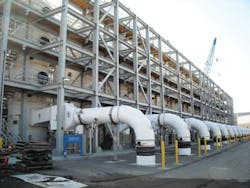By Mary-Ellen Esquer, Paul Flick and Walid T. Karam
Beyond its aging equipment, another reason for replacing the headworks facility was its location in a seismically vulnerable area - above a major branch of the Newport-Inglewood strike-slip fault. Insufficient diversion capacity and new industry codes also added to the importance of replacing the existing facility. But even with starting from scratch, the project proved to be a challenging one.
OCSD worked with Carollo Engineers to identify a suitable location for the new facility. The area's susceptible geology meant a subsurface exploration program and site-specific seismic response study were necessary to develop structural design criteria. OCSD had also recently built and expanded a number of other facilities at Plant No. 2, leaving few sites from which to select. In addition, the new headworks needed to accommodate the locations and hydraulics of existing sewer interceptors and primary treatment facilities.
Through the years, neighborhoods and public use facilities have continued to grow in the areas surrounding OCSD's treatment plants, making odor and noise control higher priorities than ever before.
To mitigate these issues and protect its community, OCSD worked with Carollo to design and implement the largest two-stage biotower odor control system in the United States. This new system treats more than 188,000 cubic feet of foul air per minute and reduces hydrogen sulfide emissions to 0.15 ppm, well below regulatory requirements. Foam biotowers remove the bulk of the hydrogen sulfide, and wet chemical scrubbers handle the rest. By removing most of the hydrogen sulfide in the biotower phase (as opposed to the chemical phase), OCSD has dramatically reduced chemical costs while improving operator and public safety.
Many other new technologies played a significant role in the design process. Influent pumping and flow routing are common challenges in facilities similar to OCSD's headworks. The ability to contain, split, and divert millions of gallons of incoming raw sewage is critical to the plant's operation.
With this in mind, OCSD and Carollo conducted extensive computational fluid dynamic (CFD) modeling of the critical hydraulic structures to ensure that design conditions met or exceeded the latest Hydraulic Institute standards and will meet future capacity demands. This CFD modeling won the 2005 Engineering Research Achievement Award from both the California Water Environment Association and its Santa Ana River Basin Section.
The new headworks influent pump station has a firm capacity of 340 mgd. It consists of a 45-foot-deep, split wet well and seven vertical non-clog centrifugal pumps driven by 700 hp, medium voltage vertical motors with variable frequency drives.
During construction, there were anticipated issues with sequencing and commissioning regarding operations. The existing plant was unable to shut down to allow for the necessary connections, diversions, and switchovers during construction of the new facility. To minimize disruption to plant operations, OCSD and Carollo developed extensive, step-by-step construction sequencing, startup testing, and commissioning plans. These plans promoted better communication to ensure smooth demolition and construction phases.
In 2011, the new headworks became fully operational. The completed project as well as the entire construction serves as a testament to the industry's ability to work with both old and new technologies to meet a wide array of concerns. By strategically blending the two, OCSD addressed not only the complex logistics of keeping the plant functional and up to standards, but also the growing needs of the surrounding coastal community.
About the Authors: Mary-Ellen Esquer is a Principal Technologist with Carollo Engineers. She has 24 years of experience in process engineering on water and wastewater projects involving planning, design, and construction management services. Walid Karam is a Senior Project Manager with Carollo Engineers, and has 23 years of experience as a sanitary enginee. Paul Flick is Carollo's National Marketing Manager.




